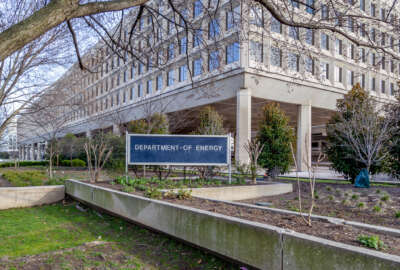One group urges the Energy Department to tweak its statistics
One group is pushing for everything to go electric and found that some of the data that the Energy Department uses need a little tweaking.
The Energy Department maintains extensive data on the cost of various energy sources used for various purposes. One group pushing for everything to go electric has found that some of that data needs a little tweaking. Wael Kanj, who does research for Rewiring America, joined the Federal Drive with Tom Temin to discuss.
Interview transcript:
Tom Temin: And you looked at a set of data that comes from the Energy Information Administration and found that they don’t quite measure the costs of electric heating correctly. What did you find here and what was your methodology?
Wael Kanj: Yeah. So a little bit of background on who we are and why we are sort of interested in this report. So we’re an electrification nonprofit working to electrify homes, businesses and communities. And we’re interested in this because about 40% of energy related emissions come from the things we do in our homes, like how we heat and cool them, how we heat our water, cook our food. And so for folks who are concerned about climate change, going electric is something they can do to take meaningful personal action. And so that’s why we’re interested and sort of glad to see that the Winter Fuels Outlook from the Energy Information Administration, or the EIA, updated its methodology this year to provide a clearer picture of heating costs for homes which heat with fossil fuels versus homes which heat with electric. And the reason we were interested in the report this year in particular was that in prior years, the EIA, when they forecasted energy costs for American households, they didn’t distinguish between the costs for heating versus for overall powering the home. And for homes which heat looked like tricity specifically, there’s actually a lot of electricity use for other things in the home besides heating. Whereas if you think about sort of natural gas or delivered fuels in homes, if the home uses that for heating, that’s typically the main sort of source of that main use for that fuel. Whereas they’re using electricity for a refrigerator or microwave as well. So I really felt like this was a more clear picture for households and for policymakers to understand what the forecast for heating fuel costs in the upcoming winter would be. And so we’re really encouraged by this change. But we do think that there are still more changes that can be made to give a clearer picture of heating fuel costs.
Tom Temin: And looking at the chart here. Are you trying to say that with, say, propane fuel, it’s twice as much to heat a home as electricity? That’s roughly what the chart looks like here.
Wael Kanj: We published a sort of a news release that replicates charts from the EIA’s fuel report. And I think it should be made clear that what the Winter Fuels Outlook is. It’s not doing a direct comparison for a given household to heat with different fuels. They’re looking out for homes which currently heat with these different fuels. What might their fuel costs be in this winter based on? They do some really good analysis looking into forecasts for how cold it might be, what retail energy prices might be as well. And so when they show approximately double the cost for propane or fuel oil heating as it is for electricity, what they’re saying is that for homes which already heat with those heating fuels, they might pay about twice as much as homes which are heat with electricity. It’s important to note, however, that homes which heat with propane and heating oil are typically located in cooler parts of the country, like the Northeast, states like Maine and New Hampshire and Vermont, which obviously have much colder winters than places where electricity heating is more popular, which is places in the south.
Tom Temin: Sure. We’re speaking with Wael Kanj. She’s a researcher for Rewiring America. You have the additional problem, I guess, from a data sense is that costs vary wildly from state to state. Some states have expensive fuels and inexpensive electricity. Some have electricity that’s more expensive than fuels on a per Btu basis. And then you’ve got places like California, which are expensive across the board for everything.
Wael Kanj: Sure. And I think that the Winter Fuels Outlook does a good job of factoring in how they expect retail energy prices to differ in different geographies around the country. And so they do factor that into their fuels outlook. And so while we do think that the sort of shift to separating out the specific costs of heating for electricity versus other end uses provides a clearer picture for folks. I think actually a big driver of differences in heating costs, which aren’t yet captured in the report, are separating out the costs or distinguishing the costs of heating a home, using electric resistance versus something like a heat pump.
Tom Temin: Right. Yeah, well, heat pumps use electric resistant when it gets too cold. I know because I’ve got one in my own basement and you can feel the difference of what’s coming out of the duct. And just a quick detailed question. You compare heating oil, propane, electricity and methane gas. Is methane, by that, you mean natural gas?
Wael Kanj: Sure. I think a lot of folks refer to as natural gas. We refer to it here as methane gas because the primary component of what’s called natural gas is methane. And to your point about heat pumps and electric resistance, I think it’s worth clarifying that while heat pumps can use and many of them do use electric resistance back up and that’s something that can come installed and heat pumps sort of handle load on the absolute coldest days of the year. There are still two distinct heating systems. So there are homes who heat only with electric resistance.
Tom Temin: Right.
Wael Kanj: Which, if folks aren’t familiar, is essentially the same way that a toaster oven works. Electricity heats up coils. It’s essentially a 1-to-1 exchange from energy use to heat. A heat pump is not actually producing the heat. It is just transferring heat from, in the case of heat in your home, outdoors to indoors.
Tom Temin: Right.
Wael Kanj: And many folks are familiar with a heat pump in terms of an air conditioner, which just works in the opposite. A heat pump in this context can switch directions in both heat and cool a home. And it’s typically about two to four times more efficient than electric resistance.
Tom Temin: And they’ve gotten a lot better in recent years because I’ve had three of them over the years because which gets me to the question of capital costs. Because if you buy a gas furnace, it’ll last 50 years. Heat pumps, you got to throw them out every 15 years or so. So does the total cost and the purported effect on the climate take into account that you have to make a lot of heat pumps versus how many furnaces you have to build because furnaces are much, much simpler and last a lot longer?
Wael Kanj: I think in general, we see that the lifetimes of furnaces can also be something like 15 or 20 years. I think very old ones might last for 50 years. But a heat pump is also pretty similar to an air conditioner. And so a lot of folks are installing air conditioners. And a heat pump is essentially the same technology that, as I said, just reverses. And so when folks are looking at installing air conditioners, they can also think about installing in its place a heat pump which reverses direction. And so there are differences in upfront costs. But I think our focus here is really on looking at.
Tom Temin: Sure.
Wael Kanj: How can forecasts for ongoing costs and actually energy costs for homes differ for folks who are using electric resistance and heat pumps and how making that distinction is really just giving more accurate or precise information to the public.
Tom Temin: Right. And getting back to the EIA, which is our real point here then, are you finding that there data gathering and analysis across the board is more accurate in terms of what real costs are to real people?
Wael Kanj: The Winter Fuels Outlook is a really comprehensive and looking at their methodology, they do incorporate, I think, a lot of important information. They make the point that sort of the main drivers of how much folks will pay for energy are things like the climate where they live, that year’s weather in terms of how cold it is and the home’s characteristics. So if it’s a very large home, smaller home, if it’s well or poorly insulated. And so the EIA’s report is, I think does a really good job of incorporating good information in terms of energy prices as well as home characteristics from their Residential Energy Consumption Survey, or RECS, which is a data source that we actually use as well. So yeah, I think the report is very well laid out and the distinction between heating and, as I mentioned, other uses within the home is a welcome change this year. I think it would be nice to see it sort of carried through in more parts of the report. And then the EIA also makes note of their report that they do not yet distinguish between heat pumps and electric resistance and that they’re exploring ways to make that distinction moving forward, which we think is our sort of like first recommendation for making this report even more useful.
Copyright © 2025 Federal News Network. All rights reserved. This website is not intended for users located within the European Economic Area.
Tom Temin is host of the Federal Drive and has been providing insight on federal technology and management issues for more than 30 years.
Follow @tteminWFED






